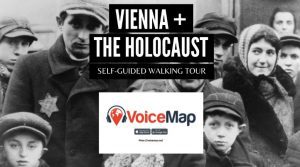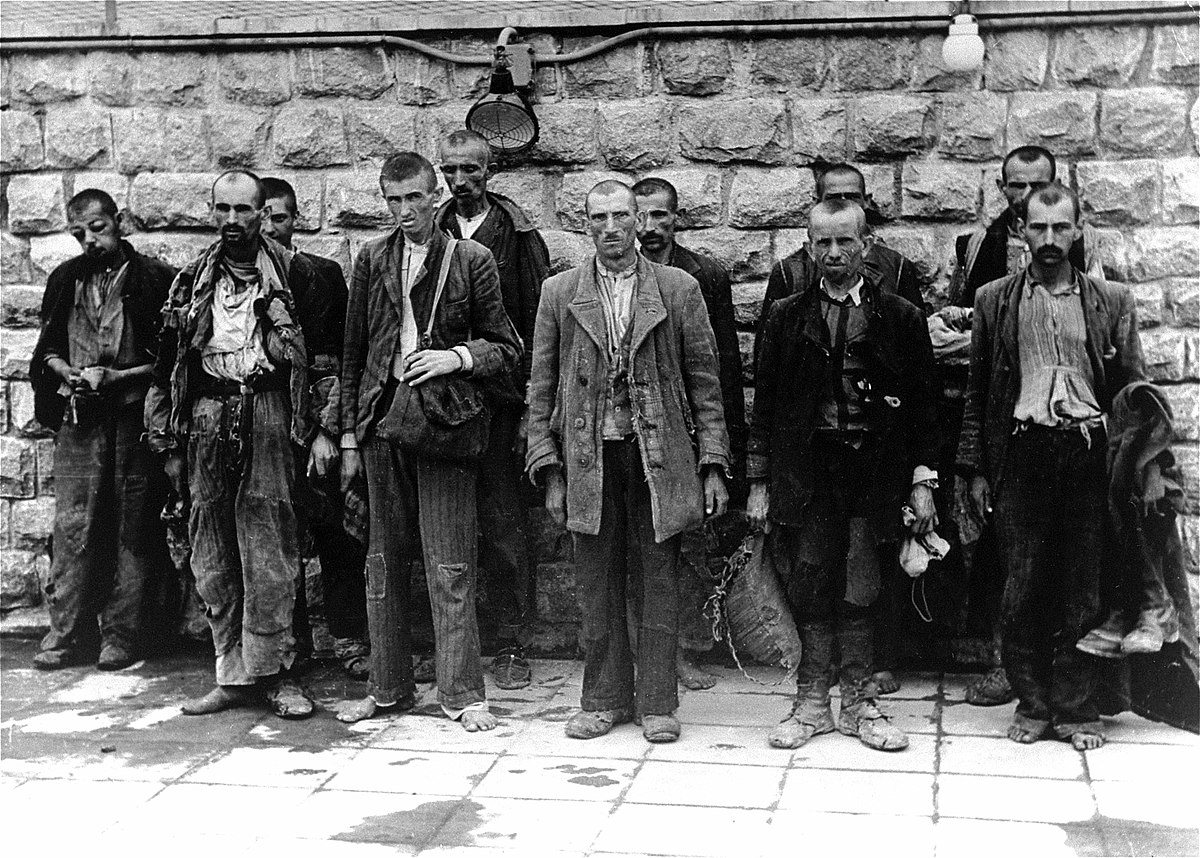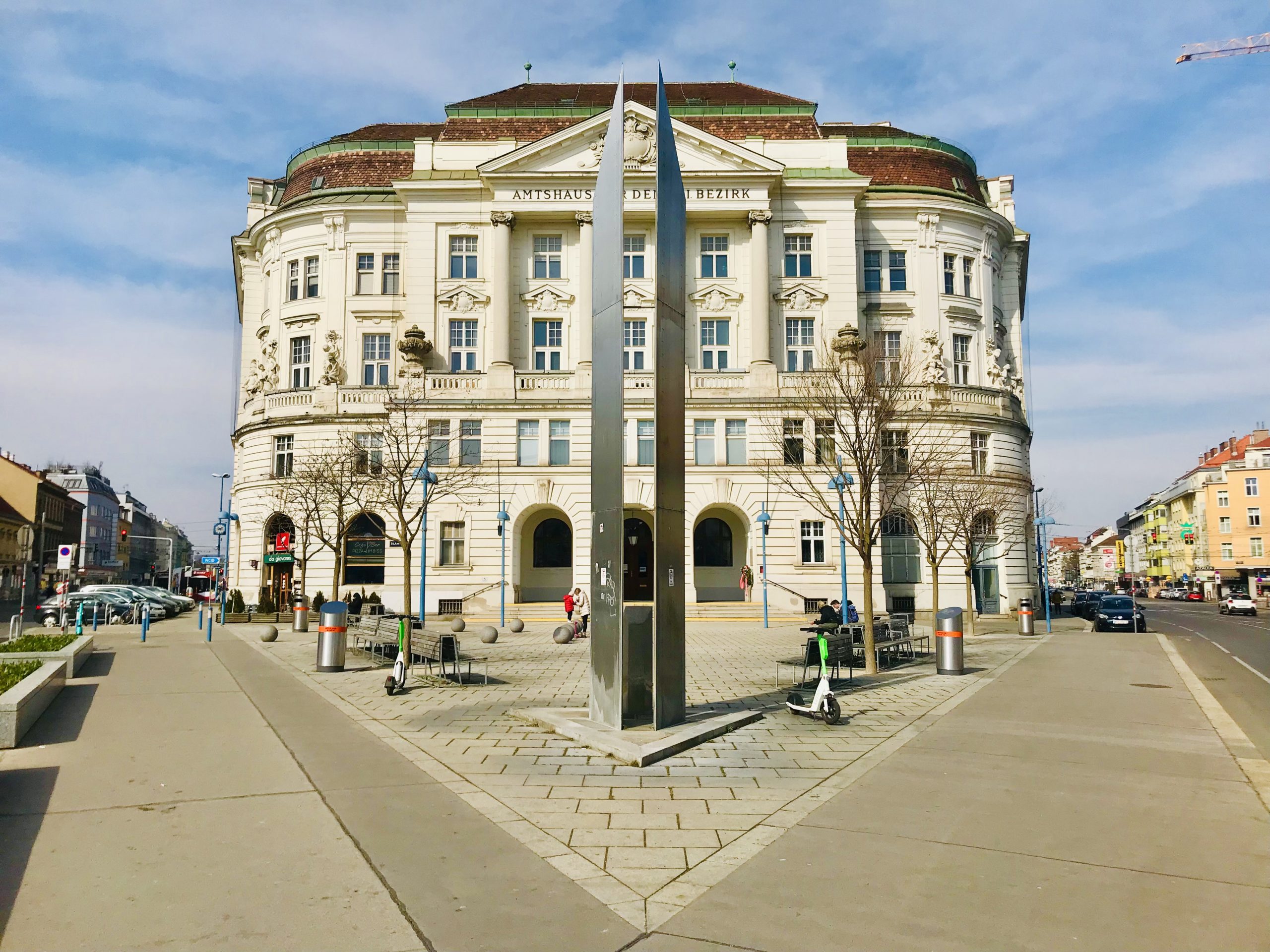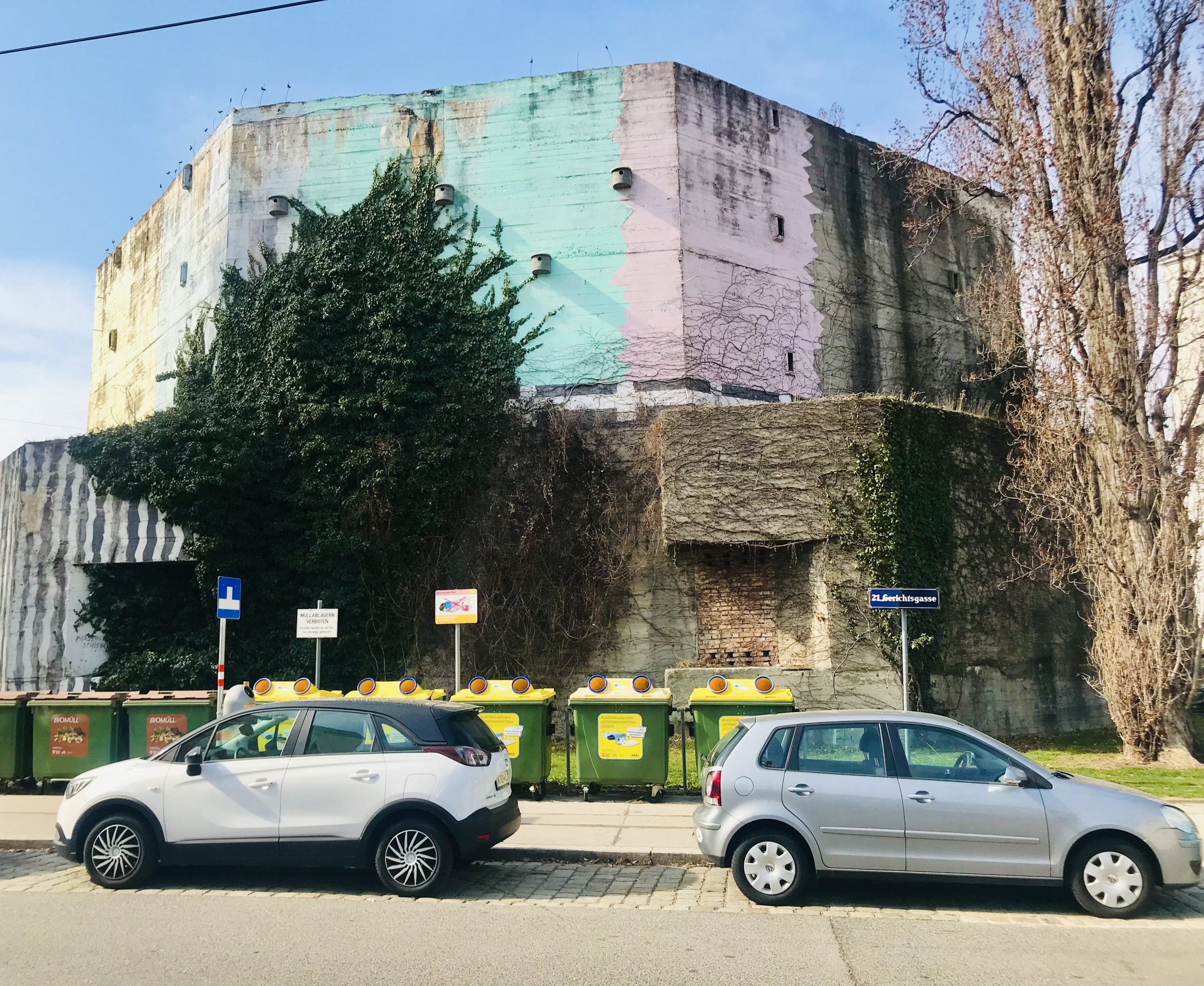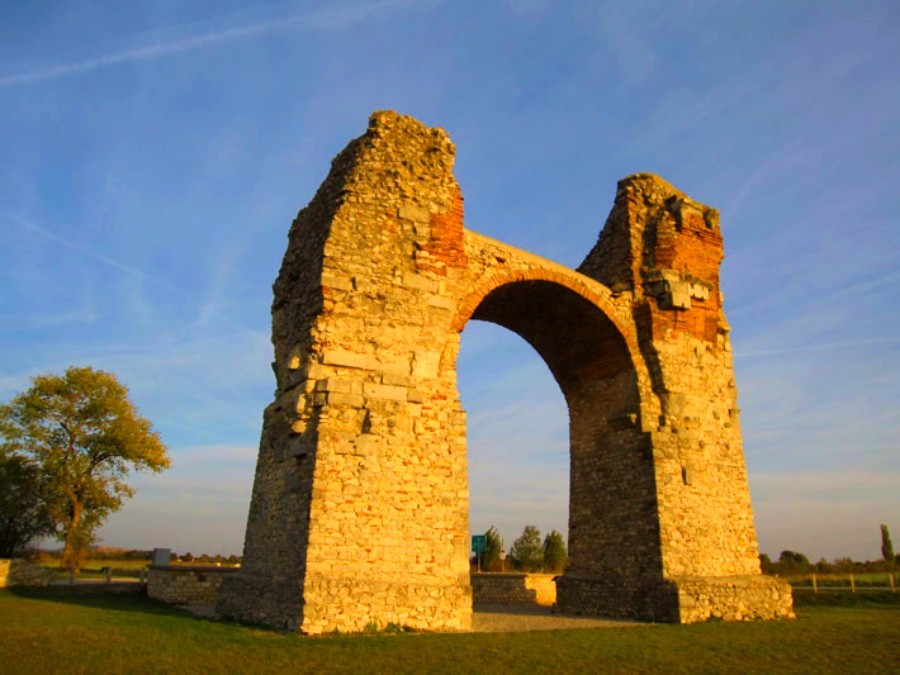
CARNUNTEM PETRONELL ROMAN ARCHAEOLOGICAL PARK: A MAJOR GLADIATOR SCHOOL AND CITY ON THE DANUBE ARE BROUGHT BACK TO LIFE
Table of Contents
Carnuntum Petronell is a sleepy village located along the Danube River on the border between Austria and Slovakia. At one time, however, Carnuntum Petronell was the 1,600-acre Roman capitol city of the Danube region. Vindobona (modern-day Vienna) was a small backwater Roman trading post of little significance. Roman soldiers in Carnuntum were in charge of defending of the “Limes” — the no man’s land border region along the Danube River. The territory north of the Limes was occupied by Barbarians. It was not part of the Roman Empire. Today, the secrets of the past have been unearthed at the Carnuntum Petronell Roman Archaeological Park. Read on!
A BRIEF HISTORY
Carnuntum has played an interesting role throughout Roman history. Carnuntum is first mentioned as a major Roman city during the reign of Caesar Augustus. Future emperor Tiberius (then a Roman general) established his winter camp in Carnuntum. He departed Carnuntum with four Legions to defeat the Marcomanni tribe and secure the Limes — the northern border of the Roman Empire.
From 166-188 A.D., Emperor Marcus Aurelius spent time in Carnuntum commanding his Legions against Germanic tribes. During this period, it is likely that his 11-year-old son, the future Emperor Commodus (the reviled Emperor in the Ridley Scott movie Gladiator), first witnessed the gladiatorial contests that would become his ruling passion.
 wikipedia commons
wikipedia commons
Located along the Danube River, Carnuntum quickly grew into a city of 50,000 inhabitants and became the capital of the Roman province of Pannonia Superior. Carnuntum had a large regional military camp and also had a flourishing civilian city (municipium).
Until the collapse of the Roman Empire in 430 A.D., Carnuntum was a strategic Roman military and trading post along the Danube River. It was the home of the VII, X, XIV and XV Roman Legions. Throughout the Empire, Carnuntum was well known as a hub for trading amber.
Carnuntum was also known for having one of the largest gladiator schools in the Roman Empire as well as the fourth largest amphitheater. The remains of the gladiator school were discovered in September 2011 using aerial photographs and ground-penetrating radar (LIDAR).
As the Roman Empire collapsed in the 4th century A.D., Rome’s borders contracted and the Legions withdrew from the Limes. Naturally, the Barbarians took this opportunity to invade. Carnuntum was eventually abandoned and was gradually disassembled. Building blocks, stones, and timber were carted off to be used as building materials for other construction projects in the region. Eventually, the remains of the city became buried and forgotten.
Today, you can see remnants of this once important city throughout the Carnuntum Petronell Roman Archaeological Park.
CARNUNTUM PETRONELL ROMAN ARCHAEOLOGICAL PARK
Today, archaeologists have brought the city back to life at the Carnuntum Petronell Roman Archaeological Park. For those who prefer to explore their Roman ruins in situ, archeologists have excavated a newly discovered Gladiator School, Amphitheaters, and the massive Heidentor Gate to the city. These sites are within walking distance from the Carnuntum Petronell Roman Archaeological Park and make for a great outing. Today, Carnuntum also remains an active archeological site.
ROMAN CITY QUARTER
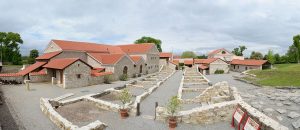 wikimedia commons
wikimedia commons
1700 years later, the original streets of Carnuntum are alive again. Through their meticulous efforts, archaeologists have recreated portions of the Roman City Quarter using early building techniques. In fact, Roman edifices have been reconstructed upon the very foundations where they once stood. Very cool!
The Roman City Quarter has examples of a citizen’s house, an upscale urban villa, and public baths. If you like Roman history, these sites are all well worth exploring.
CIVILIAN AMPHITHEATER
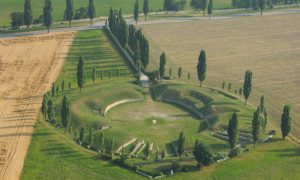 carnuntum.at
carnuntum.at
Approximately 10 minutes walk from the Roman City Quarter is the Civilian Amphitheater. Originally situated outside the Carnuntum city walls, the Civilian Amphitheater was erected towards the end of the 2nd century AD. The arena could seat 13,000 visitors.
GLADIATOR SCHOOL
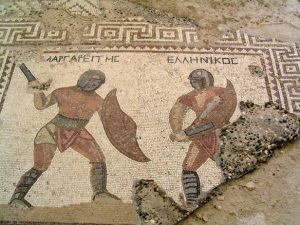 wikipedia commons
wikipedia commons
In September 2011, archaeologists used aerial photographs and ground-penetrating radar (LIDAR) to discover an ancient Roman Gladiator School to the south of the city. The Gladiator School — which housed between 40 and 60 gladiators — had training grounds, bathing facilities, an assembly hall, and dormitories for the gladiators. The school was attached to an open campus which was most likely used for chariot races.
In antiquity, the gladiator school at Carnuntum was said to have rivaled the Ludus Magnus, the great training center adjacent to the Colosseum in Rome. In July 2016, Smithsonian magazine featured an article on the newly surfaced gladiator school titled, The Discovery of a Roman Gladiator School Brings the Famed Fighters Back to Life.
Accompanying the Gladiator School is a small and often overlooked exhibit housed in the ticket office. In addition to chronicling the life of the gladiator, the exhibit contains a unique collection of weapons, and surgical tools which were unearthed at the Gladiator School.
MILITARY AMPHITHEATER
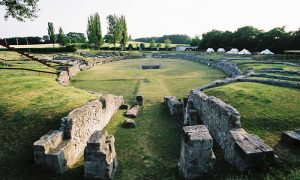 carnuntum.at
carnuntum.at
Next to the Gladiator School is a large amphitheater. Visitors to the site will easily identify the tunnel that connects the School to the amphitheater. This is the route the Gladiators took when entering the amphitheater. If you look closely, you will also see the remnants of enclosures for the exotic animals featured in the gladiatorial games. If you are really observant, you will notice the VIP seating area for the provincial governor. Go inspect this area. You will notice there is box seating (similar to today) and the box can only be entered from two passageways.
HEIDENTOR (HEATHEN’S GATE)
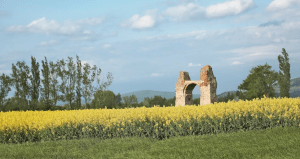 google maps 2022
google maps 2022
The Heidentor (Heathens’ Gate) is located 900 meters south of Carnuntum’s civilian city and was presumably erected during the reign of Emperor Constantius II (351–361 AD). The Gate is a quadrifrons, a monument on four pillars with two intersecting passageways. The Heidentor was shaped like a cube — each side was 14.5 meters long.
The large 4.5 meter tall pedestal in the middle, which blocks the passageways, tells us the Heidentor served two purposes: it was a Gate and was also a triumphal monument. A larger-than-life statue of Emperor Constantine II probably stood on the pedestal. Flavius Julius Constantius, known as Constantine II, was Roman emperor from 337 to 361 A.D.
CARNUNTEM MUSEUM
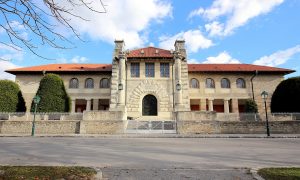 wikimedia commpons
wikimedia commpons
After exploring the Carnuntum Petronell Roman Archaeological Park, check out the fantastic Carnuntum Museum in town. It contains the finds from various excavations at Carnuntum since the 1850s. If you are fascinated by the Roman Empire, the museum is a must-see.
THE QUARRY
Easily overlooked, next to the museum along the river, is the quarry where the materials for Carnuntum were mined. Imagine how materials were quarried and then transported to the city.
OUR EXPERIENCE AT THE CARNUNTUM PETRONELL ROMAN ARCHAEOLOGICAL PARK
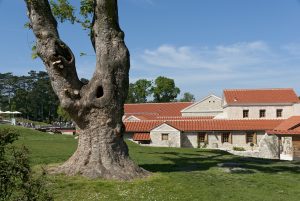 wikipedia commons
wikipedia commons
My wife, teenage son, and I spent the day exploring the reconstructed Roman City Quarter (which is an active archeological site). We then visited Gladiator school, the Amphitheaters, and the Carnuntum Museum. Lastly, we made our way to the site most identifiable with Carnuntum — the Heidentor (Heathens Gate).
Truth be told, we were skeptical about visiting a reconstructed Roman settlement. After visiting Rome, Pompeii, Herculaneum, Diocletian’s Palace, Carthage, Hadrian’s Wall and a multitude of other Roman sites, we found the reconstructed buildings to be quite interesting. In fact, as avid enthusiasts of all things Roman, we had never seen anything like this. Seeing the before and after of these sites through photographs and having a real hands-on experience gave us a whole new perspective on the Roman lifestyle. Indeed, families of all ages will find this an interesting place to explore.
Our favorite part of the Gladiator School was the out of the way exhibit inside the small discreet ticket office next to the site. The exhibit featured an interesting collection of gladiator weapons and surgical instruments used by the physicians of the day. Reading the Smithsonian article (please see below) and watching a documentary on the newly discovered gladiator school helped bring the site to life. Overall, there was little in terms of information in English to put things into context. You should definitely read up before you visit.
After departing the Gladiator School, we visited the Roman museum in the small village of Carnuntum Petronell. The museum houses a treasure trove of artifacts from the city and is a must-see.
Lastly, we stopped at the Heidentor (Heathen’s Gate) for photos of what would have been one of the major entrances into the Roman city. Today, Heathen’s Gate proudly stands alone as an ancient symbol of Roman power against the backdrop of several farm fields. As we looked through the arch, we imagined what it must have been like entering into a bustling Roman city of 50,000 inhabitants.
Bottom line — if you enjoy Roman history then a trip to the Carnuntum Petronell Roman Archaeological Park is a must. It has a bit of something for everyone.
PRO TIPS FOR VISITING THE CARNUNTUM PETRONELL ROMAN ARCHAEOLOGICAL PARK
The following PRO TIPS will help you make the most of your experience at the Carnuntum Petronell Roman Archaeological Park.
PRO TIP 1. The reconstructed buildings in the Roman City Quarter really make history come to life, especially for children. Encourage them to be as hands-on as possible to get the most out of their experience.
PRO TIP 2. To make the most of your visit, read the Smithsonian magazine article The Discovery of a Roman Gladiator School Brings the Famed Fighters Back to Life . Watch the documentary Lost City of Gladiators.
PRO TIP 3. Dogs on a leash are welcome throughout the Carnuntum Petronell Roman Archaeological Park.
PRO TIP 4. Do not forget to budget time (two hours) to visit the Roman museum in the small modern town of Carnuntum Petronell.
PRO TIP 5. Plan your day accordingly as the Roman city quarter in Carnuntum has little to offer in terms of cafes and restaurants. We packed a picnic lunch with tables/chairs and made good use of the grassy fields near the settlement site. Remember to pack water bottles.
PRO TIP 6. The site is spread out over 1,600 acres. There is quite a bit to explore and you will need a car or bicycle to see everything in one day.
NEAR THIS PLACE
CYCLING THE RADWEG NEUSIEDLERSEE. Cycling along the Radweg Neusiedlersee in Burgenland is a must. Explore Rust, one of the most charming towns in Austria.
VOICEMAP | VIENNA SELF GUIDED WALKING TOUR. Want to learn how the Mossad operation to bring Nazis like Adolf Eichmann to justice originated in Vienna? Check out our VoiceMap self guided walking tour: VIENNA + THE HOLOCAUST: FROM TRAGEDY TO JUSTICE. You can preview it for FREE. Start point is Nestroyplatz on the U1 red line in the 2nd District.
PETRONELL CASTLE. These Castle ruins and a cute town are located a few miles away in the town of Hainburg an der Donau.
BEST PLACES TO STAY
HOTEL MARC AUREL. Minutes away from the Carnuntum Archaeological Park and Petronell Castle. Rooms feature elegant furniture. Garden terrace, FREE Wi-Fi bicycle storage and parking. ADDRESS: Hauptstraße 10, 2404 Petronell, Austria.
HOTEL ALTES KLOSTER. 5-10 minute drive to Carnuntum Archaeological Park. Hotel is a 17th-century monastery in the historic town center of Hainburg. Sauna, steam bath, FREE parking, and FREE E-Bike/E-Car charging.ADDRESS: Fabriksplatz 1, 2410 Hainburg an der Donau, Austria.
APARTMENTS BRIGITTE. 15-20 minutes drive to Carnuntum Archaeological Park. Clean with modern contemporary architecture. 5-10 minutes from Bratislava Castle and Old Town Bratislava. FREE parking. ADDRESS: Brižitská 5, Dubravka, 841 01 Bratislava, Slovakia.
FILM + TV
RESOURCES
Carnuntum App w/ Virtual Reality (Apple and Google Play Store)
Roman City Quarter and Interactive Map
The Discovery of a Roman Gladiator School Brings the Famed Fighters Back to Life
![]()



